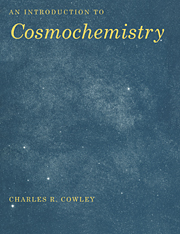Book contents
- Frontmatter
- Contents
- Foreword
- 1 Overview
- 2 Minerals: An Introduction to the Nomenclature and Chemistry
- 3 A Brief Introduction to Petrology
- 4 A Résumé of Thermodynamics and Statistical Mechanics
- 5 Condensation Sequences and the Geochemical Classification of the Elements
- 6 The Theory of the Bulk Composition of the Planets
- 7 Meteorites and the Standard Abundance Distribution (SAD)
- 8 An Introduction to Isotope Geology with an Emphasis on Meteorites
- 9 Some Concepts from Nuclear Physics
- 10 Energy Generation in Stars and Nucleosynthesis
- 11 Atomic and Molecular Spectra
- 12 The Analysis of Stellar Spectra
- 13 The Chemistry of Stars and Stellar Systems
- 14 Cold, Non-stellar Material in Galaxies
- 15 Emission-Line Regions and their Chemical Abundances
- 16 Abundances of the Elements in Galaxies
- Appendix
- References
- Index
12 - The Analysis of Stellar Spectra
Published online by Cambridge University Press: 05 June 2012
- Frontmatter
- Contents
- Foreword
- 1 Overview
- 2 Minerals: An Introduction to the Nomenclature and Chemistry
- 3 A Brief Introduction to Petrology
- 4 A Résumé of Thermodynamics and Statistical Mechanics
- 5 Condensation Sequences and the Geochemical Classification of the Elements
- 6 The Theory of the Bulk Composition of the Planets
- 7 Meteorites and the Standard Abundance Distribution (SAD)
- 8 An Introduction to Isotope Geology with an Emphasis on Meteorites
- 9 Some Concepts from Nuclear Physics
- 10 Energy Generation in Stars and Nucleosynthesis
- 11 Atomic and Molecular Spectra
- 12 The Analysis of Stellar Spectra
- 13 The Chemistry of Stars and Stellar Systems
- 14 Cold, Non-stellar Material in Galaxies
- 15 Emission-Line Regions and their Chemical Abundances
- 16 Abundances of the Elements in Galaxies
- Appendix
- References
- Index
Summary
The Identification of Lines in Stellar Spectra
We start our discussion of the analysis of stellar spectra with line identifications. In chemistry, this would be called qualitative analysis. With line identification, we find out which elements and ions are present in stellar atmospheres, leaving the quantitative analysis to subsequent techniques.
The most thoroughly explored stellar spectrum is surely that of the sun. The region from λλ2935–8770, essentially the traditional spectrum available from the ground, is described in a volume by Moore, Minnaert, and Houtgast (1966). This work is a revision of a previous study that was, itself, revised from a still older work. No one at the present time needs to begin the study of any stellar spectrum from first principles. It will be possible in virtually every case to find some at least relevant identification list for a star whose spectrum is similar in nature to the one for which new identifications are desired.
Many of the classical identification studies were done from a list of measured wavelengths, for which the measurer had supplied eye estimates of the line intensities. In modern work one could always have in addition to the list of wavelengths, a tracing of the spectrum, such as the one shown in Figure 12.1. On tracings such as this, one quickly identifies some of the strongest features, such as the hydrogen lines, the resonance lines of Ca II, called H and K, or the strong lines of iron.
- Type
- Chapter
- Information
- An Introduction to Cosmochemistry , pp. 260 - 288Publisher: Cambridge University PressPrint publication year: 1995



